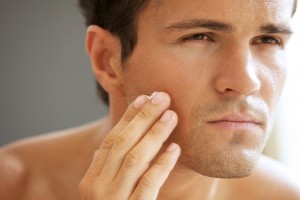The skin on a man versus that on a woman is significantly different. The ability to grow a beard is just one obvious distinction among many others that are not so evident. From a structural point of view, some of the differences include skin thickness, collagen density, loss of collagen as we age, texture and hydration. These differences in the skin may in fact create differences in the treatment room. Let’s look at each of these aspects in more detail.
Skin Thickness
We know that the thickness of the skin varies with the location, age and sex of the individual. Additionally, androgens (i.e. testosterone), which cause an increase in skin thickness, accounts for why a man’s skin is about 25 percent thicker than that of a woman’s. A man’s skin also thins gradually with age, whereas the thickness of a woman’s skin remains constant until about the age of fifty. After menopause, her skin will thin significantly, which will continue as she ages.
Collagen Density
Regardless of age, men have a higher collagen density than women; this is the ratio of collagen to the thickness of the skin. Researchers believe that the higher collagen density accounts for why women appear to age faster than men of the same age. When considering intrinsic (genetically-programmed) aging of the skin, it has been said that women are about 15 years older than men of the same age. Of course, the role of daylight exposure in skin aging, combined with the fact that men do not use sunscreen as often as women, may account for why we do not readily notice. Extrinsic aging from UV radiation can add years to a man’s skin and negate the benefit of slower intrinsic aging.
Loss of Collagen
The physical signs of aging in adults, such as wrinkles and laxity to the tissue, are closely related to the collagen content of the skin. Both men and women lose about one percent of their collagen per year after their 30th birthday. For women, however, this escalates significantly in the first five years after menopause then slows down to a loss of two percent per year.
Texture
From a superficial perspective, the texture of a man’s skin is very different than a woman’s. The texture (on a man) is rougher, and the Stratum Corneum is thicker. There is also a difference in the composition of sebum and its production. After puberty, sebum production is greater in males than in females, which is attributed to androgen secretions and accounts for why men have longer lasting acne. The cells in a man’s sebaceous glands have more positive receptors for androgens, which explains why they produce more sebum. Interestingly, redness, proliferation of the sebaceous glands and swelling of the skin on the nose, (a condition known as rhinophyma that is found in extreme cases of rosacea) is only seen in males. It is unknown if this condition is controlled by androgens in a similar capacity as sebum production.
Hydration
Puberty also stimulates the appearance of facial hair in men and gives rise to sweat secretions. Males have more Lactic Acid in their sweat, which accounts for a lower pH (.05 lower) when compared to female sweat. Men also sweat more than twice as much as women and are more prone to sweating, which is stimulated by an increase in body temperature. However, male skin appears to be better hydrated than women’s, which is fortunate, as men are less likely to apply a hydrating moisturizer to their body or face. Perhaps the excess sweating and production of Lactic Acid, a known natural humectant for the skin, is responsible for the level of tissue hydration.
Treating a Man’s Skin
The health of a man’s skin is, of course, just as important as that of a woman. But while treatment for a man sometimes differs from a woman, remember that the same amount of care must be taken regardless of the sex of the client. Even if the man appears to have tough, resilient skin, he may still have internal issues or surround himself in environments that sensitize him. In every instance, use the consultation card to familiarize yourself with the client, and never assume that a man needs any less gentle care than a woman.


